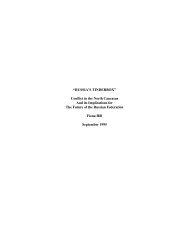The Heart of the Matter Valerie M. Hudson, - MIT Press Journals
The Heart of the Matter Valerie M. Hudson, - MIT Press Journals
The Heart of the Matter Valerie M. Hudson, - MIT Press Journals
You also want an ePaper? Increase the reach of your titles
YUMPU automatically turns print PDFs into web optimized ePapers that Google loves.
<strong>The</strong> <strong>Heart</strong> <strong>of</strong> <strong>the</strong> <strong>Matter</strong> 35<br />
rity and behavior are thus faced with a serious challenge. <strong>The</strong>re are 6 to 10<br />
variables concerning women that are easily quantiªed and that form <strong>the</strong> basis<br />
for most analysis <strong>of</strong> <strong>the</strong> situation <strong>of</strong> women in <strong>the</strong> world today. But to advance<br />
a research agenda linking <strong>the</strong> security <strong>of</strong> women and <strong>the</strong> security <strong>of</strong> states,<br />
more robust capabilities must be developed. Scholars must expand beyond <strong>the</strong><br />
conªnes <strong>of</strong> <strong>the</strong> most easily obtainable information, and <strong>the</strong>y must incorporate<br />
not only statistics but also more detailed qualitative information. <strong>The</strong> empirical<br />
research agenda we wish to advance, <strong>the</strong>n, requires creation <strong>of</strong> <strong>the</strong> means<br />
by which it could effectively be pursued. We created <strong>the</strong> WomanStats Database<br />
to address this need. This database compiles data on more than 260 variables<br />
concerning <strong>the</strong> security and situation <strong>of</strong> women for 174 states, and currently<br />
contains more than 100,000 data points. 93<br />
Realizing <strong>the</strong> frequent discrepancy between rhetoric, law, and practice, we<br />
seek data on three aspects <strong>of</strong> each phenomenon in which we are interested—<br />
law, practice/custom, and statistical information. This allows researchers to<br />
access useful and reliable data regardless <strong>of</strong> <strong>the</strong>ir preferred method <strong>of</strong> inquiry,<br />
quantitative or qualitative. Quantitatively oriented researchers can ªnd statistics<br />
on <strong>the</strong> prevalence <strong>of</strong> particular practices as readily as qualitatively oriented<br />
researchers can locate narrative information on <strong>the</strong> experiences and lives<br />
<strong>of</strong> women. We are thus able to provide a richer data source for researchers<br />
dissatisªed with relatively superªcial indicators and empower <strong>the</strong>m to create<br />
<strong>the</strong>ir own indices. For example, when examining <strong>the</strong> phenomenon <strong>of</strong> domestic<br />
violence, we collect data not only on <strong>the</strong> incidence <strong>of</strong> domestic violence and<br />
laws concerning domestic violence but also custom and practice concerning<br />
domestic violence. So, for example, is domestic violence generally reported?<br />
Why or why not? What is <strong>the</strong> level <strong>of</strong> societal support for victims <strong>of</strong> domestic<br />
violence, such as <strong>the</strong> existence <strong>of</strong> shelters and hotlines? How is fault decided in<br />
legal cases concerning domestic violence? What is <strong>the</strong> range <strong>of</strong> punishment for<br />
this <strong>of</strong>fense? Is violence sometimes sanctioned by <strong>the</strong> culture, such as in <strong>the</strong><br />
cases <strong>of</strong> “disobedience” by a wife or daughter? Are <strong>the</strong>re regional, religious, or<br />
ethnic differences in <strong>the</strong> incidence <strong>of</strong> domestic violence within <strong>the</strong> society? Are<br />
<strong>the</strong>re o<strong>the</strong>r barriers to enforcement <strong>of</strong> <strong>the</strong> law, such as low arrest and/or conviction<br />
rates? In <strong>the</strong> WomanStats Database, <strong>the</strong>re are 7 variables on domestic<br />
violence alone; 11 on rape; 15 on marriage practice, and so forth. 94<br />
93. Caprioli et al., “<strong>The</strong> WomanStats Project Database.”<br />
94. <strong>The</strong> data are freely accessible to anyone with an internet connection, thus facilitating worldwide<br />
scholarship on <strong>the</strong>se issues. Contribution <strong>of</strong> data via remote upload is also possible for approved<br />
credentialed sources. See http://www.womanstats.org.
















